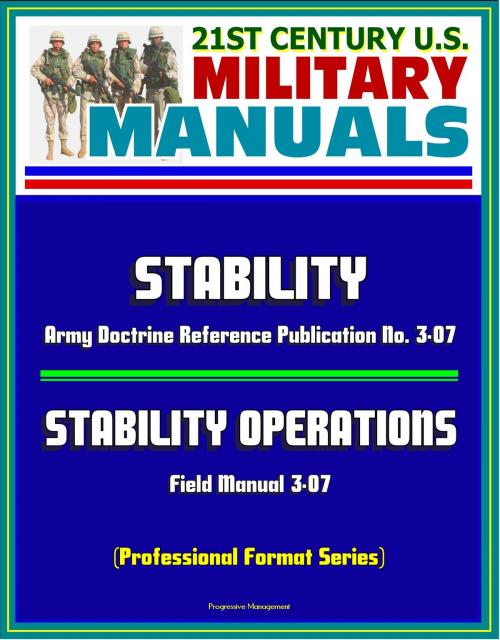21st Century U.S. Military Manuals: Stability - Army Doctrine Reference Publication No. 3-07 and Stability Operations Field Manual 3-07 (Professional Format Series)
Nonfiction, History, Military, United States| Author: | Progressive Management | ISBN: | 9781301306527 |
| Publisher: | Progressive Management | Publication: | November 29, 2012 |
| Imprint: | Smashwords Edition | Language: | English |
| Author: | Progressive Management |
| ISBN: | 9781301306527 |
| Publisher: | Progressive Management |
| Publication: | November 29, 2012 |
| Imprint: | Smashwords Edition |
| Language: | English |
Professionally converted for accurate flowing-text e-book format reproduction, two Army publications provide information on stability operations. The first document is Stability ADRP 3-07 (Army Doctrine Reference Publication No. 3-07). The second document is the Stability Operations Field Manual 3-07.
Army Doctrine Reference Publication (ADRP) 3-07 augments the stability doctrine established in Army Doctrine Publication (ADP) 3-07, Stability. ADP 3-07 is the Army's doctrine for stability tasks. ADP 3-07 presents overarching doctrinal guidance and direction for conducting these operations, setting the foundation for developing other fundamentals and tactics, techniques, and procedures detailed in subordinate doctrinal publications. It also provides operational guidance for commanders and trainers at all echelons.
It constitutes the Army's view of how to conduct stability tasks in operations on land and sets the foundation for developing the other principles, tactics, techniques, and procedures detailed in subordinate doctrinal publications. Combined with ADP 3-07, the doctrine in ADRP 3-07 provides a foundation for the Army's operational concept of unified land operations. This publication also forms the foundation for training and Army education curricula on stability tasks in operations.
Field Manual (FM) 3-07 is the Army's keystone doctrinal publication for stability operations. FM 3-07 presents overarching doctrinal guidance and direction for conducting stability operations, setting the foundation for developing other fundamentals and tactics, techniques, and procedures detailed in subordinate field manuals. It also provides operational guidance for commanders and trainers at all echelons and forms the foundation for Army Training System curricula.
The six chapters that make up this edition of Stability Operations constitute the Army's approach to the conduct of full spectrum operations in any environment across the spectrum of conflict. This doctrine focuses on achieving unity of effort through a comprehensive approach to stability operations, but remains consistent with, and supports the execution of, a broader "whole of government" approach as defined by the United States Government (USG). The core of this doctrine includes the following:
Chapter 1 describes the strategic context that frames the Army's comprehensive approach to stability operations. It includes discussion of the strategic environment, USG strategy and policy, and interagency efforts to define an integrated approach to stability operations that leverages the collective efforts of a wide array of actors toward a commonly understood and recognized end state.
Chapter 2 links full spectrum operations to broader efforts aiming to achieve stability, emphasizing the simultaneous nature of offensive, defensive, and stability tasks. It describes the phasing paradigm that defines stability operations activities conducted before, during, and after combat operations.
Chapter 3 addresses the essential stability tasks that comprise military stability operations. Chapter 4 discusses the fundamental principles of the detailed component of planning, focused on the stability element of full spectrum operations. Chapter 5 addresses transitional military authority and provides doctrine concerning command responsibility, establishment, and organization of military government to support stability operations. Chapter 6 provides the doctrinal foundation for security sector reform, and introduces security force assistance as the capacity-building activity that encompasses organizing, training, equipping, rebuilding, and advising host-nation security forces.
Professionally converted for accurate flowing-text e-book format reproduction, two Army publications provide information on stability operations. The first document is Stability ADRP 3-07 (Army Doctrine Reference Publication No. 3-07). The second document is the Stability Operations Field Manual 3-07.
Army Doctrine Reference Publication (ADRP) 3-07 augments the stability doctrine established in Army Doctrine Publication (ADP) 3-07, Stability. ADP 3-07 is the Army's doctrine for stability tasks. ADP 3-07 presents overarching doctrinal guidance and direction for conducting these operations, setting the foundation for developing other fundamentals and tactics, techniques, and procedures detailed in subordinate doctrinal publications. It also provides operational guidance for commanders and trainers at all echelons.
It constitutes the Army's view of how to conduct stability tasks in operations on land and sets the foundation for developing the other principles, tactics, techniques, and procedures detailed in subordinate doctrinal publications. Combined with ADP 3-07, the doctrine in ADRP 3-07 provides a foundation for the Army's operational concept of unified land operations. This publication also forms the foundation for training and Army education curricula on stability tasks in operations.
Field Manual (FM) 3-07 is the Army's keystone doctrinal publication for stability operations. FM 3-07 presents overarching doctrinal guidance and direction for conducting stability operations, setting the foundation for developing other fundamentals and tactics, techniques, and procedures detailed in subordinate field manuals. It also provides operational guidance for commanders and trainers at all echelons and forms the foundation for Army Training System curricula.
The six chapters that make up this edition of Stability Operations constitute the Army's approach to the conduct of full spectrum operations in any environment across the spectrum of conflict. This doctrine focuses on achieving unity of effort through a comprehensive approach to stability operations, but remains consistent with, and supports the execution of, a broader "whole of government" approach as defined by the United States Government (USG). The core of this doctrine includes the following:
Chapter 1 describes the strategic context that frames the Army's comprehensive approach to stability operations. It includes discussion of the strategic environment, USG strategy and policy, and interagency efforts to define an integrated approach to stability operations that leverages the collective efforts of a wide array of actors toward a commonly understood and recognized end state.
Chapter 2 links full spectrum operations to broader efforts aiming to achieve stability, emphasizing the simultaneous nature of offensive, defensive, and stability tasks. It describes the phasing paradigm that defines stability operations activities conducted before, during, and after combat operations.
Chapter 3 addresses the essential stability tasks that comprise military stability operations. Chapter 4 discusses the fundamental principles of the detailed component of planning, focused on the stability element of full spectrum operations. Chapter 5 addresses transitional military authority and provides doctrine concerning command responsibility, establishment, and organization of military government to support stability operations. Chapter 6 provides the doctrinal foundation for security sector reform, and introduces security force assistance as the capacity-building activity that encompasses organizing, training, equipping, rebuilding, and advising host-nation security forces.















